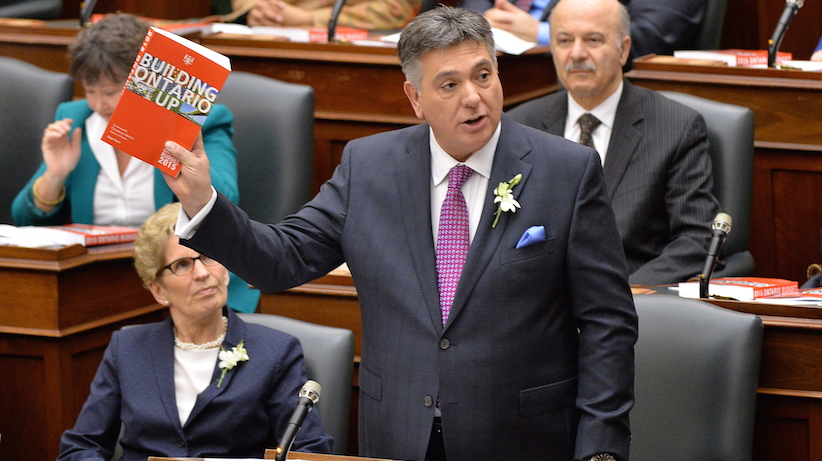Ontario on the (long) road to a balanced budget
How the Ontario government plans to erase its deficit by 2017-18: infrastructure and asset sales
Ontario Finance Minister Charles Sousa delivers the provincial budget as Premier Kathleen Wynne looks on at Queen’s Park in Toronto on Thursday, April 23, 2015. THE CANADIAN PRESS/Nathan Denette
Share

It’s going to be a long and winding road to balance Ontario’s budget by 2017-18.
Last year, the province’s deficit was $10.9 billion. This year, Ontario Finance Minister Charles Sousa forecast a budget deficit of $8.5 billion. Next year, it will be less than $5 billion, until the books are balanced in time for the 2017 budget.
The Liberals say they will “unlock value of certain provincial assets” (read: sell land and buildings). Among those assets: the Ontario Power Generation head office building in downtown Toronto, as well as land near Pickering, as well as Lakeview lands in Mississauga.
While the news of beer sales arriving in local grocery stores made headlines in March, Ontario is also looking to sell the head office of the Liquor Control Board of Ontario (LCBO) in Toronto.
Ontario will also “broaden the ownership in Hydro One” (read: sell the majority of its common shares) with an initial public offering of 15 per cent of the utility, at first. The province plans to keep a 40 per cent stake in Hydro One, while proposing legislation that would limit any other shareholder (or group of shareholders) to no more than 10 per cent of common shares. The money from the remaining 60 per cent—a net gain of approximately $4 billion, officials claim—will then be reinvested in Ontario’s Trillium Trust, a fund dedicated to infrastructure and transportation. The Trillium Trust already has $1.35 billion in its coffers, the bulk of that thanks to the province netting $1.1 billion from the sale of its shares in General Motors earlier this year.
By 2022, the government will “shrink its office footprint” by 1.3 million sq. feet (the equivalent of more than 75 hockey rinks). This will be achieved by selling buildings or destroying old ones that are no longer needed.
Semantically, selling government assets and buildings never sounded so good, with the goal of the sales adding $5.7 billion to the province over 10 years. The Liberals say they are building the province up. The Conservatives, on the other hand, call it a shell, adding that selling off public assets hampers revenue streams moving forward. The NDP, meanwhile, worries the “fire sale” of Hydro One will lead to higher electricity bills.
With a majority government in hand and another provincial election years away, the Ontario Liberals are mostly staying on course with the budget they tabled last year. There were no major cuts to this year’s books, nor were there any significant taxes. Instead, the government sees investment in infrastructure as a direct path to a balanced budget.
With $11.9 billion worth of planned investment in the coming year, key projects range from widening highways in eastern Ontario to a Waterloo Rapid Transit Plan in southwestern Ontario. Over the next 10 years the provincial Liberals plan to invest more than $130 billion. Yet for Toronto’s SmartTrack transit plans to go ahead, the province will require a funding partner. It won’t come from the feds. The federal budget from Finance Minister Joe Oliver earlier this week did little to appease the province. The $750 million that Ottawa is dedicating to infrastructure over two years, followed by $1 billion per year thereafter, was dismissed as “crumbs.” (The province did, however, credit the federal government as a “key partner” in supporting the automotive sector, matching Ontario’s total contributions of nearly $140 million for plants in Guelph, Oakville and Cambridge.)
The Ontario government sees a virtuous circle unfolding from its asset sales. The revenue will be invested in infrastructure like bridges, public transit and roads, which will lead to more jobs, shorter commutes, and hence higher growth and a better standard of living for people in the province.
But at the end of the road to a balanced budget by 2017-18, the province will still have that one big pothole to fix: $341 billion in debt.